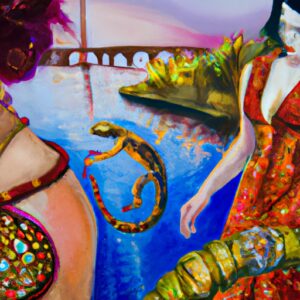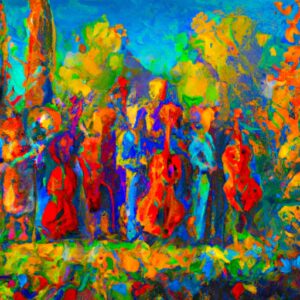The Italian lifestyle is widely imitated around the world.
It is made up of small and large habits that combine to produce a unique and sought-after image.
All aspects of life are valued and celebrated by Italians, including spending time with family and friends, eating and drinking well, and appreciating beauty in all its forms.
Italian lifestyle and traditions
Italy has a population of more than 60 million people as of 2021 and is ranked 23rd in the world in terms of population size (worldometers.com).
The arte (arts), famiglia (family), architettura (architecture), musica (music), and cibo (food) are all important aspects of Italian culture.
Culture on the Italian peninsula has flourished for centuries since it was the home of the Roman Empire and a major center of the Renaissance.
Whether you are Italian or you just have a love for the culture, here is a quick rundown of the Italian lifestyle and traditions.

Drinking Coffee
Coffee, which was introduced in the 1500s, has established its own culture in Italy.
The day is defined by coffee traditions: a cappuccino with breakfast, a caffè macchiato – or two – as an afternoon pick-me-up, and espresso after dinner.
And, as with any society, the rules governing Italian coffee seem to be mysterious.
If you order a latte, you will also receive a glass of milk (which is exactly what you ordered). Ask for a to-go cup or order a cappuccino after 11 a.m. and risk an instant tourist tag.
Learn more about Italian coffee here.
Italian wine
The world of Italian wine can be intimidating—in a country smaller than the state of California, some estimate there are over 2,000 distinct native grape varieties, 400 of which are used in commercial wine-making.
Since every province in Italy produces and exports wine, there is a multitude of regions to keep track of!
But the good news is that there is something for everyone among Italy’s wines; the geographically diverse country produces a fascinating selection of regional specialties in every style and price point you can imagine.
As a bonus, Italian wines are famously food-friendly across the board, so you’re sure to find the ideal pairing for anything from pasta night to a frutti di mare (seafood) extravaganza to an antipasti picnic.
And keeping a stock of wine at home in case anyone drops by is one of the most important habits with which we can define the Italian lifestyle.
Learn more about Italian wine here.
Italian luxury brands
Italian apparel is widely regarded as among the finest in the world. Florence leather has a solid reputation, and Southern Italy is the epicenter of luxury footwear manufacturing.
But what are some of the most well-known Italian fashion labels?
At Milan Fashion Week, big names like Gucci, Prada, Fendi, and Versace are calling cards, but the shoe-shaped nation is more than just these four.
Add some Miu Miu, Giorgio Armani, and Valentino to the mix, and we’ve got ourselves a list.
And remember:
Mai indossare sandali con calzini bianchi!
Never wear sandals with white socks!
Learn more about Italian luxury brands here.
Italian Jewelry
Jewelry design, like Italian fashion design, possesses a diverse blend of passione (passion), ispirazione (inspiration), and immaginazione (imagination) that translates into incredible, wearable art pieces.
In Italy, the world’s most attractive jewelry is meticulously handcrafted. Italy is well known in the world for its highly professional jewelers.
A piece of Italian jewelry is much more than a trendy and elegant decoration; its creation is founded on a diverse cultural tradition and centuries of inventive recognition.
A fusion of cultural influences in the prosperous Roman Empire resulted in an art that, even today, demonstrates a high level of ingenuity and passion.
These early goldsmiths, along with the high demand for the luxury of their trade, were the primary stimulants for the impeccable standards and variety of Italian jewelry design that exists today.
Learn more about Italian jewelry here.
Italian furniture
Fine quality and exceptional craftsmanship have always been hallmarks of Italian architecture.
Textile art, natural fabrics, and light elements, as well as a diverse range of furniture, will never go out of style.
It’s difficult to imagine an interior setting without Italian influence, as it remains timeless in a sea of trends.
Who doesn’t want to add a touch of Italian lifestyle to their home?
Get to know more about Italian furniture here.
Italian violin makers
Many people associate Italian violini (violins) with the archetype of lutherie. The oldest surviving violin, the best violin of all time, and the most famous violin are all made in Italy.
Since the 1950s, artisanal violin making has been experiencing a revival in Cremona, where the violin’s history dates back over a millennium.
Following a decline in Cremona, a slew of new violin makers have sprouted around the international violin-making academy, and it is here that Italian Cremona violin-making is being redefined.
Learn more about Italian violin makers here.
Italian marble
While marmo (marble) is mined in numerous nations across the world, one country is often regarded as the source of the most high-grade and exquisite marble accessible — Italy.
It is, without a doubt, the place of origin for the most famous marble, but what is it about Italian marble that makes it so desirable?
The history of Italian marble is rich. It was used by renaissance artists such as Michelangelo and Donatello to build some of the world’s most renowned works of art, such as the David statue.
Italian marble has proven to stand the test of time and has been used on many monuments around the world for ages.
Italian cars
At first, the Italian lifestyle was a bit of a culture shock.
Lunch is a leisurely affair, with a dish after a course of delectable fresh cuisine arriving at your table.
There is no rush in the afternoons when all the stores and restaurants close, and everyone goes home to rest before returning for the second part of the day.
There is one major exception to this calm and easy way of life: cars.
Fast cars. Cab drivers are not uncommon in telling tourists who are new to Italy that “stop signs and red lights are simply raccomandazioni (recommendations)!”
It’s also no coincidence that the majority of Italy’s top vehicle manufacturers are all known for their speed!
Learn more about Italian luxury cars here.
Italian motorcycles
Italians adore two-wheeled vehicles, and it’s safe to say that they’re unrivaled when it comes to riding, designing, and producing them.
Motorbikes are a wonderful way to move around in Italy, especially in cities where traffic is frequently severe, and parking is a never-ending challenge.
Companies such as Piaggio developed stunning designs such as the Vespa, which took over Italian strade (streets), as well as high-cylinder motorbikes.
Italy soon surpassed Japan as the largest manufacturer of these types of bikes.
Learn more about the best Italian motorcycles here.
Italian yacht
Italy, also known as Il Bel Paese (The Beautiful Country), is one of the most recognizable countries on any map.
Tourists in Italy travel in different ways, such as trains, cars, and aircraft, but more than ever before, many visitors are opting to sail throughout the country.
A sailing tour is one of the greatest ways to get the most out of the Italian coastline and relax under the Mediterranean sun, with its rich history, gorgeous warm waters, Mediterranean climate, islands, and unique landscapes.
You can enjoy the charms of the Italian lifestyle by boat, and you may choose from many boat types, such as catamarans, sailing boats, and yachts.
Learn more about Italian yachts here.
Final thoughts
Many people have long been fascinated by Italy’s rich history, culture, architecture, cuisine, and other elements.
The Italian lifestyle has been exported all over the world, and everyone wants to know how to add a little bit of it into their everyday lives.
After all, you can’t really understand a culture until you go there and immerse yourself in it.
However, now you have everything you need to experience “la dolce vita” (the sweet life) and get a greater appreciation for it.
Cosa stai aspettando?
What are you waiting for?









